| Pages:
1
2 |
garage chemist
chemical wizard
    
Posts: 1803
Registered: 16-8-2004
Location: Germany
Member Is Offline
Mood: No Mood
|
|
Storage of pressurized liquid SO2 in plastic containers
Today I liquefied some SO2 (around 20g) in a flask, using my lab cryostat for cooling. I poured it into a clean, dry, heavy walled 300ml PET softdrink
bottle and capped it, to test the chemical resistance of the PET plastic. After warming up, there was no smell of SO2 around the cap, and the bottle
was nicely pressurized.
Two hours later the liquid SO2 was gone, and the bottle smelt very strongly of SO2 on the entire outside. Upon releasing the residual pressure, I
found that the plastic had softened uniformly and not just where the liquid SO2 was in contact with it.
While PET is technically resistant against SO2 (I found this info in at least one chemical resistance chart), it seems like diffusion through it is
extremely rapid and there also seems to be some swelling and softening of the material due to SO2 takeup. So a PET bottle is, unfortunately, not
suitable as a container for liquid SO2 despite the relatively low pressure (4-5 atmospheres).
Has anyone done similar experiments, or devised ways of storing SO2 under pressure without using metal containers?
I don't have suitably heavy-walled PE or PP containers, nor do I have any idea where such could be found.
|
|
|
watson.fawkes
International Hazard
    
Posts: 2793
Registered: 16-8-2008
Member Is Offline
Mood: No Mood
|
|
It
used to be that outdoor equipment stores carried PE or HDPE water bottles.
|
|
|
peach
Bon Vivant
    
Posts: 1428
Registered: 14-11-2008
Member Is Offline
Mood: No Mood
|
|
Absolutely tons of plastic bottles are PP or PE, they're a major section of all the plastics used for packing domestic commodities. If you search
eBay.co.uk for 'plastic bottles' you'll find a large amount of them. You want to avoid any that look crystal clear, as they are likely PET. The rest
will be PP or PE. They do tend to be the thinner walled kind, the heavy walled ones are out there. When I buy bottles of drain sulphuric, it comes in
a solid white PE bottle with a thick wall. I'd post you mine actually, but it's still pretty much full. If I find an almost empty one I'll let you
know; but I've likely thrown it out if it was near empty.
I'm looking at a graph for the vapour pressure of SO2 now, and it appears to be around 3-4 bar at room temperature; 40 to 60psi.
Things like fizzy drinks bottles are usually rated to burst at about 200psi. But I wouldn't feel too happy storing any serious quantity of SO2 in a
plastic bottle at 40-60psi. If it doesn't burst, it's probably going to try making it's way through the plastic or around the seal anyway.
Store it in the freezer and the pressure drops to around 0.7 bar.
{edit}As watson suggests, have a look at plastic water bottles for camping, hiking or running. They are quite often much heavier walled than others
due to them getting beaten up in rucksacks or out in fields. The stores hardly ever list what they're made from, so check the bottle for the recycling
symbol. 2 in a triangle for HDPE, 5 for PP.
{edit2}I want to see your cryostat. 
[Edited on 26-2-2011 by peach]
|
|
|
hissingnoise
International Hazard
    
Posts: 3940
Registered: 26-12-2002
Member Is Offline
Mood: Pulverulescent!
|
|
I don't know which polymer is used for the ordinary, small water bottles but they're readily chewed up by
H<sub>2</sub>SO<sub>4</sub>
|
|
|
garage chemist
chemical wizard
    
Posts: 1803
Registered: 16-8-2004
Location: Germany
Member Is Offline
Mood: No Mood
|
|
Nevermind, I found an old drinking bottle made of sturdy aluminium that appears quite perfect for the purpose once I replace the crumbling old rubber
gasket with one made of PTFE.
It appears quite ideal for ammonia too, since aluminium is completely resistant against both wet and dry ammonia.
Now I only need to drill a hole for the connector into the cap and find some kind of valve.
OK, I'll make a pic of my cryostat. It goes to -60°C and I've liquefied ammonia in it. I call it the "no more dry ice machine" since I'll never have
to buy dry ice again as long as it works.
|
|
|
Magpie
lab constructor
    
Posts: 5939
Registered: 1-11-2003
Location: USA
Member Is Offline
Mood: Chemistry: the subtle science.
|
|
That's a nice project GC, and I too would like to see your cryostat.
Quote: Originally posted by garage chemist  | Nevermind, I found an old drinking bottle made of sturdy aluminium that appears quite perfect for the purpose once I replace the crumbling old rubber
gasket with one made of PTFE.
|
I'm surprised that you found a drinking bottle with a screwed cap that could give you a good enough seal for 3-4 bar. But I suppose you can tolerate
a tiny bit of leakage. PTFE does seem to give a pretty good seal on my glass bottles for ether.
Is the cap thick enough to allow you to screw in a nipple or will it have to be welded? A needle valve with PTFE seat and packing would seem good but
might be expensive too. Maybe even an HDPE seat and packing would be OK too.
The single most important condition for a successful synthesis is good mixing - Nicodem
|
|
|
peach
Bon Vivant
    
Posts: 1428
Registered: 14-11-2008
Member Is Offline
Mood: No Mood
|
|
Quote: Originally posted by hissingnoise  |
I don't know which polymer is used for the ordinary, small water bottles but they're readily chewed up by
H<sub>2</sub>SO<sub>4</sub>
|
If it's crystal clear and 'crackles' as you scrunch it up, it'll be PET. Pretty much all the disposable drinks bottles are PET.
The kind I'm thinking of, and I expect watson, are the ones you're supposed to reuse; that are usually opaque and thick walled.
|
|
|
Eclectic
National Hazard
   
Posts: 899
Registered: 14-11-2004
Member Is Offline
Mood: Obsessive
|
|
Why the need for plastic container? What about used empty propane cylinders for low pressure gasses? (gas over liquid)
|
|
|
Magpie
lab constructor
    
Posts: 5939
Registered: 1-11-2003
Location: USA
Member Is Offline
Mood: Chemistry: the subtle science.
|
|
Quote: Originally posted by Eclectic  | Why the need for plastic container? What about used empty propane cylinders for low pressure gasses? (gas over liquid)
|
That was my first thought also. In fact it seems that you could use the Schrader type valve already built into the gas bottle both for filling (with
gas), using, and sealing. Attach a regular propane nozzle and you have a needle valve for use and filling (with gas) too. Compatibility of the soft
parts in the valves with SO2 (dry, and a little wet) would need to be verified. I'm not sure if these valves could be used to fill the tank with
liquid, but I don't see why not. Anyone know?
For an easy fill with a liquid a larger fill port would work well.
[Edited on 27-2-2011 by Magpie]
[Edited on 27-2-2011 by Magpie]
The single most important condition for a successful synthesis is good mixing - Nicodem
|
|
|
Eclectic
National Hazard
   
Posts: 899
Registered: 14-11-2004
Member Is Offline
Mood: Obsessive
|
|
I'm pretty sure the "Schrader" valve is spring loaded pressure relief, but there are adapters available for refilling from the main port.
|
|
|
Magpie
lab constructor
    
Posts: 5939
Registered: 1-11-2003
Location: USA
Member Is Offline
Mood: Chemistry: the subtle science.
|
|
I just went out to the lab and checked my 400g propane bottle. It appears to have a small Schrader looking valve on the dome - but I guess this is a
pressure relief valve. However, the externally threaded discharge port does have a Schrader valve which is opened when the valved nozzle or regulator
is screwed on to the port.
[Edited on 27-2-2011 by Magpie]
[Edited on 27-2-2011 by Magpie]
The single most important condition for a successful synthesis is good mixing - Nicodem
|
|
|
garage chemist
chemical wizard
    
Posts: 1803
Registered: 16-8-2004
Location: Germany
Member Is Offline
Mood: No Mood
|
|
I can't use empty propane cylinders since I want to pour the liquefied SO2 into the cylinder and then seal it. The types of valves in use here can't
be removed, and I don't have a compressor that I could use for SO2.
|
|
|
condennnsa
Hazard to Others
  
Posts: 217
Registered: 20-4-2010
Location: Romania
Member Is Offline
Mood: No Mood
|
|
how did your setup for liquefying SO2 look like? did you make it from burning sulfur? and yes, please if you can, take a pic of your cryostat
|
|
|
garage chemist
chemical wizard
    
Posts: 1803
Registered: 16-8-2004
Location: Germany
Member Is Offline
Mood: No Mood
|
|
I added 30% HCl from a dropping funnel to solid potassium metabisulfite, and gently heated the flask with a bunsen burner to liberate the gas. The SO2
passed a washing bottle with a little H2SO4 and then went on to the cooled condensation flask.
Conc. H2SO4 for drying SO2 is not an ideal choice, the solubility of SO2 in this is quite high (100g/kg) and increases with sinking concentration. A
CaCl2 drying tube would be better, but I wanted a visual indication of gas flow, and the H2SO4 in the wash botle was already saturated with SO2 from a
previous batch so there were no losses.
You can't use burning sulfur as a SO2 source for this.
If you burn sulfur with air to use up most of the oxygen, you get around 13% SO2 in nitrogen plus residual oxygen.
When this gas is cooled to -50°C, only half of the SO2 condenses out, giving an offgas with around 6% SO2.
In industry, this offgas is fed to a contact process H2SO4 plant.
At home, losing half of the SO2 to the atmosphere would be unacceptable. Also, -50°C is not easily reached with a freezer.
At the -20 to -30°C that I was working at, nothing would condense from sulfur burner offgas.
You need to prepare pure SO2 from a sulfite salt or by reduction of H2SO4 with e.g. copper turnings.
|
|
|
gsd
National Hazard
   
Posts: 847
Registered: 18-8-2005
Member Is Offline
Mood: No Mood
|
|
Quote: Originally posted by garage chemist  |
You can't use burning sulfur as a SO2 source for this.
If you burn sulfur with air to use up most of the oxygen, you get around 13% SO2 in nitrogen plus residual oxygen.
When this gas is cooled to -50°C, only half of the SO2 condenses out, giving an offgas with around 6% SO2.
In industry, this offgas is fed to a contact process H2SO4 plant.
At home, losing half of the SO2 to the atmosphere would be unacceptable. Also, -50°C is not easily reached with a freezer.
At the -20 to -30°C that I was working at, nothing would condense from sulfur burner offgas.
You need to prepare pure SO2 from a sulfite salt or by reduction of H2SO4 with e.g. copper turnings.
|
Actually in industry, the liquid SO2 is made by SO2 from burner gas but not by direct cooling / condensation process.
The burner gas containing about 10-12 % SO2 is first scrubbed with water to absorb most SO2. (IIRC the solubility of SO2 in water is about 20% at 30
Deg C.) Inert gasses are let-off from scrubber and the water laden with SO2 is stripped by steam heating. The gas released now is almost pure SO2 with
some water vapours - which are removed by H2SO4 wash and the SO2 is compressed and liquified in Compressor and Chiller.
gsd
|
|
|
garage chemist
chemical wizard
    
Posts: 1803
Registered: 16-8-2004
Location: Germany
Member Is Offline
Mood: No Mood
|
|
Pics!
The Cryostat itself, a Haake Q combined with recirculator and thermostat F3.
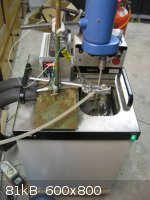
Instead of using the thermostat F3, I added a selfbuilt controller that switches the cooling on and off at adjustable temperature limits (-20 and
-30°C for this application). The controller is actually a PID controller but I use it as a two-point thermostat since PID control is totally
incompatible with compressor cooling. I also added an overhead stirrer since there is no stirring when the recirculator is switched off.
The original method of temperature control was that the cooling was running the whole time, and the thermostat was heating against it to keep the bath
temperature constant. Extremely wasteful of electricity. I changed this as soon as I got it. Now, the cooling only runs 10% of the time.
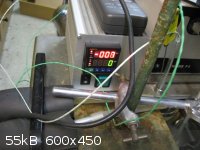
The SO2 gas generator. I am heating sulfuric acid with sulfur. This is a very cheap and convenient method. The acid has to be above 300°C to react
with the sulfur, and the water has to be constantly distilled off. The SO2 stream is quite slow.
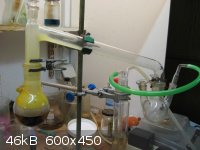
The condensation flask. The inlet tube runs down to the bottom.
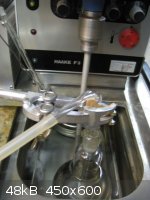
You can see the droplets of liquid SO2 on the walls of the flask here.
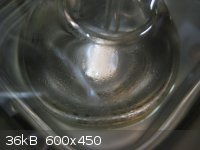
And here's the stirrer shaft covered with frost, since it's made of aluminium and conducts heat very well.
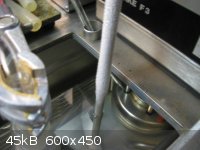
[Edited on 28-2-2011 by garage chemist]
|
|
|
NurdRage
Hazard to Others
  
Posts: 182
Registered: 11-11-2010
Member Is Offline
Mood: No Mood
|
|
Can i ask what you want to use your SO2 for?
This is not a perfect all around solution, but for some things this is pretty good: Store the SO2 as a solution in methanol.
SO2 has a VERY high solubility in methanol (i think 40%+ by mass), and at room temperature the SO2-methanol solution is very convenient to handle and
can be added directly to various reactions where the methanol isn't a problem.
I've done it personally and have used it to make sodium dithionite and reduce manganese dioxide.
[Edited on 28-2-2011 by NurdRage]
|
|
|
garage chemist
chemical wizard
    
Posts: 1803
Registered: 16-8-2004
Location: Germany
Member Is Offline
Mood: No Mood
|
|
I eventually want to develop a catalytic reactor for SO3 production from SO2 and air, and in order to have a gas stream of constant and finely
adjustable composition I want SO2 gas "on tap", meaning from a gas cylinder.
Also, I need it for gold and platinum group metals refining, and not having to set up a gas generator every time I want to precipitate gold would be
an advantage.
Dissolving SO2 in an alcohol is an idea I also had, in order to wash it out of the offgas from a sulfur burner. Ethanol, which I had in mind,
dissolves 200 times its own volume of SO2 at 0°C.
But I now found that the reduction of H2SO4 with sulfur works so well that I will produce all of the SO2 for the cylinder that way.
I will use "recycled" sulfuric acid for this, which is mostly spent nitrating acid from various aromatic nitrations that I have boiled down to
density 1,8. Reduction with sulfur is a good way to turn it into something useful.
|
|
|
NurdRage
Hazard to Others
  
Posts: 182
Registered: 11-11-2010
Member Is Offline
Mood: No Mood
|
|
Interesting,
yeah the alcohol method is probably not good for a catalytic gas reactor.
Good idea with the reduction method. Sounds like you're all set.
I look forward to your future setup 
|
|
|
peach
Bon Vivant
    
Posts: 1428
Registered: 14-11-2008
Member Is Offline
Mood: No Mood
|
|
First of all, NICE setup. 
What are you thinking of using for the cylinder?
The commercially available ones usually rot around the valve stem, where they're in contact with moisture. Or the tap jams because moisture has gotten
into there as well. So, if it's going towards a cylinder, it may help extend it's lifespan if all of the glassware is blown out with anhydrous
cylinder gas before the generation starts. And the cylinder it's self. Blowing the cylinder out may be harder work. The typical method for getting all
the damp air out of something is to first put it under vacuum and then backfill, sometimes a few times over. Argon is expensive compared to air, but
has the added advantage that it should more easily displace the air given that it's heavier than it.
There's a picture of a HCl(g) cylinder on curly arrows blog with the stem corroded shut. The cylinder has a very, very basic setup on it, which is
just a brass flow control stuck on the valve stem.
The really expensive Matheson manifolds for corrosive gases will have a purge feature, to blow the gas out and displace any damp air as well, before
it's all turned off. But with any setup, blowing the corrosive material out and replacing it with dry, inert gas around the controls is going to help.
I expect you may already know some or all of this, I'm only mentioning it to save any future 'urgh!' moments if not.
|
|
|
Eclectic
National Hazard
   
Posts: 899
Registered: 14-11-2004
Member Is Offline
Mood: Obsessive
|
|
GC, have you tried to find any catalysts for the H2SO4 + S8 reaction? Copper, iron, vanadium? We had a thread on this a while back, with a lot of
"it will never work" attitude, much like the making potassium thread.
|
|
|
garage chemist
chemical wizard
    
Posts: 1803
Registered: 16-8-2004
Location: Germany
Member Is Offline
Mood: No Mood
|
|
No, the reaction goes sufficiently fast at reflux temperature, and with the bunsen burner, this is very simple to do.
I made about 40g SO2 (weighed as liquid) in 3 hours using 100g H2SO4 and 15g sulfur (obviously, a lot was left over as I had to stop since it was
getting late).
The sulfur melts into a large viscous blob that floats around in the boiling acid, evolving gas at the interface between sulfur and acid. I think that
the reaction rate depends on the area of contact between these liquids. Stirring should help, but it's entirely too hot for PTFE.
I think that using a larger amount of reagents should increase the speed of gas generation.
One should also use more than the theoretical amount of sulfur, since it tends to get volatilized and settle as a thick yellow dust coating in the
condenser.
The acid, however, is consumed practically without losses. Only the reaction water distills, provided one doesn't boil needlessly intense.
|
|
|
garage chemist
chemical wizard
    
Posts: 1803
Registered: 16-8-2004
Location: Germany
Member Is Offline
Mood: No Mood
|
|
I was not able to get the aluminum drinking bottle sufficiently gastight- there always was too much leakage around the cap to tolerate.
Instead of this, I now acquired an old 1L medical oxygen cylinder in order to fill it with SO2.
Upon disassembly of the cylinder valve, I found that the inside parts were made of brass. Experiment will have to show how much this is attacked by
SO2.
Chemical resistance databases contradict each other, but in one book, "Handbook of corrosion data" I found that most brass types resist anhydrous SO2
and are corroded by it in presence of moisture. So the situation is similar to chlorine, which needs to be perfectly dry to be bottled in steel
cylinders.
Does someone know where to look up the density of liquid SO2 at 50°C? All sources just give the density (1,46 g/ml) at the boiling point (-10°C),
but the liquid obviously expands upon warming, and if there is insufficient headspace in the cylinder, the incompressible liquid can rupture the
cylinder upon expanding despite the 150 bar rating.
I found the information that commercial 2L SO2 cylinders contain 2kg, and 10L ones contain 12kg. So I should be able to safely fill 1kg into my 1L
cylinder.
Any thoughts about that?
|
|
|
ElectroWin
Hazard to Others
  
Posts: 224
Registered: 5-3-2011
Member Is Offline
Mood: No Mood
|
|
maybe measure expansion coefficient and tell us?
|
|
|
garage chemist
chemical wizard
    
Posts: 1803
Registered: 16-8-2004
Location: Germany
Member Is Offline
Mood: No Mood
|
|
H2SO4 + S reaction is catalyzed by iron!
Today I set up a larger SO2 generator, using 120ml H2SO4 and 55g sulfur, and this time I added 2g Fe2O3 in the hope of getting a more rapid gas
stream. This made a huge difference!
The SO2 evolution began at a much lower temperature, and by the time the sulfur had become black and viscous, the mixture was bubbling vigorously and
the gas stream was so fast that the bubbles in the washing bottle could not be counted any more (estimate 6-8 bubbles per second).
The bunsen burner did not have to be set as high as without the Fe2O3- the acid was nowhere near boiling.
The gas stream was so brisk that solid sulfur aerosol was carried into the washing bottle and even into the liquid SO2, making it turbid. I need to
add a gas filter the next time.
Also, at -20°C bath temperature, there was a significant amount of SO2 escaping from the cold trap, and I had to lower the temperature to -30°C to
condense it all.
After one hour, I stopped the reaction, and 35g liquid SO2 had accumulated. The last time, I had to wait 3 hours for this amount, and the flask was
much hotter.
This iron catalysed H2SO4 + S reaction has now suddenly solved the question of "how do I make 1kg pure SO2 in one day, with cheap materials".
If 1L H2SO4 costs EUR 15 and 1kg sulfur EUR 7, then the price for 1kg SO2 (from 566ml acid and 167g S) would be EUR 9,66.
Refilling the 1kg SO2 cylinder for less than EUR 10 raw material cost, that's seriously cheap!
|
|
|
| Pages:
1
2 |